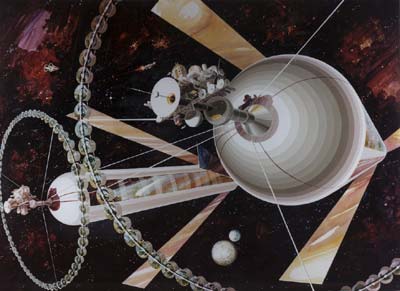|
|
 Space colonies located in L5 were all the rage in the 1970s, but today a more incremental approach starting on the Moon may make more sense. (credit: NASA Ames Research Center) |
Sidebar: Looking up from 1977 and 2005
by Sam Dinkin
Monday, February 7, 2005
There have been many technological developments O’Neill predicted that have come true in the last 30 years, such as cheap personal computers. There are many technological developments that showed promise in 1977 that O’Neill predicted would not occur, such as cheap fusion power. Two things that O’Neill did not anticipate are that the Moon may be a source of hydrogen from the pole and a source of carbon from comet strikes.
O’Neill’s mass drivers are becoming more technically feasible. The wispy kilometers-long ships that run on mass drivers for O’Neill’s vision of asteroid colonization and exploitation are becoming technically validated. The economics for a multi-year asteroid mining expedition looks very suspicious to me, especially if the alternative is Lunar prospecting for comet and asteroid strikes (see “Review: Moonrush”, The Space Review, August 16, 2004). That is not even considering the property rights question.
The mass drivers, if souped up to 50 kilometers and 10,000g, can fire material at 100 kilometers per second, which is about five times the velocity what current technology for mass drivers and rail guns can produce on one-kilogram payloads. Going to pellets that weigh 16 grams, 250,000g has been achieved, so we would only need two-kilometer guns. That would be 17 times the 6 km/s velocity achieved for that mass.
If we had two of those pointing at each other, two pellets could be shot at each other sparking fusion. I asked Geoffrey Landis what he thought about using that for Earth power. He said, “Impact fusion is occasionally discussed, but I have not seen it seriously proposed for Earth power—it needs a lot of engineering details to be worked out.” On Earth, it might require as much excavation and engineering as the Superconducting Super Collider. On the Moon the vacuum would be cheap, but the labor and materials and back-hauling would be expensive. If 10,000g is too much, a Lunar equatorial maglev train track might do the trick at 600g. However, that is a lot of train track. Landis asks, “Is there any reason to think that the cost would be similar to maglev track? What do you get out of this that you don’t get out of $500 billion in solar cells?”
Landis asked, “Have you worked out the power-out/power-in ratio?” If the two pellets each had half a kilogram of deuterium, each inside a carbon shell that would partially ablate if we don’t want create a high vacuum on Earth, then we would get about a 0.1% conversion of the deuterium to energy or one gram converted into 3.4 x 1014 J. The energy in is mv2 or 5 x 109 J. Double it for two pellets to 10 GJ. Assuming a conversion efficiency to electricity of 10%, the energy out/in is about 3,000. Build smaller pellets and shoot them off more often. There’s no proliferation problem, so it can be built wherever, and there can be many plants. My guess is that it would be a lot more expensive than coal, gas, or nuclear fission at first, but it’s clean, safe, and the fuel is nearly limitless. If we can get the efficiency up to 10% by using a steel containment and molten salt cooling system like project PACER (see “Fire and brim stone”, The Space Review, January 10, 2005), have I cracked fusion?
As to using it to give an afterburner or power plant to O’Neill’s wispy interplanetary cargo barges, Landis asked, “How heavy is a 100-kilometer-long spaceship?” Even at two kilometers, I think we are a few decades from long linear motor ships.
Return to main article
|
|
